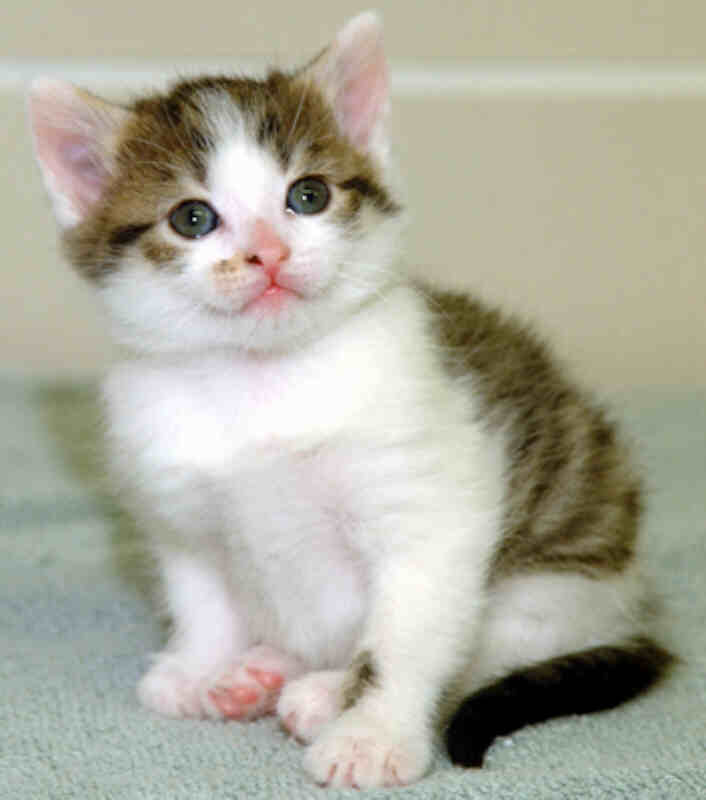
CC: THE WORLD'S FIRST CLONED CAT
at 7 weeks of age
| DNA from Rainbow was inserted in an egg from another
female cat and placed in the uterus of a surrogate mother cat. After 66
days of gestation, CC was born by caesarean section on 22 December 2001. The above picture was taken when CC was seven weeks old. CC was introduced to the world on 14 February 2002, after DNA tests verified that she is a true clone of Rainbow. The coloring of their coats differs as it can between identical twin cats, not being fully determined by the DNA. |

CC one year old (right) with Rainbow
| ONE YEAR LATER Rainbow the cat is a typical calico with splotches of brown, tan and gold on white. Cc, her clone, has a striped gray coat over white. Rainbow is reserved. Cc is curious and playful. Rainbow is chunky. Cc is sleek. Wayne Pacelle of the Humane Society might be inclined to say: I told you so. But then, so would cc’s creators at Texas A&M University. Sure, you can clone your favorite cat. But the copy will not necessarily act or even look like the original. CC is the first cloned household pet. Previous mammal clones were barnyard animals like cows and goats. Cc’s creation was funded by Genetic Savings & Clone, which hopes to profit from people’s desires to duplicate their favorite pets. In February 2002, in the journal Nature, the A&M researchers published details of the project and DNA test results that showed that Cc was a clone. But people who hope cloning will resurrect a pet will be disappointed. Environment is as important as genes in determining a cat’s personality. And as far as appearance, having the same DNA as another calico cat doesn’t always produce the same coat pattern. Cloning does not produce a physical duplicate, and it can never reproduce the behavior or personality of a cat that you want to keep around. There are millions of cats in shelters and with rescue groups that need homes, and the last thing we need is a new production strategy for cats. HUNDREDS OF SAMPLES Before the birth of Cc, Genetic Savings & Clone had hundreds of pet DNA samples stored at a cost of $895 for healthy animals and $1395 for sick or dead animals. Genetic Savings & Clone chief executive, has estimated that the cost to create a clone will initially be in the low five figures and later drop to the low four figures. Cc’s arrival resulted in numerous calls from pet owners. But more research is needed to figure out how to produce consistently healthy clones before the company can start doing it commercially. There is a demand from dog lovers, but scientists so far have been unable to clone a canine. In fact, Cc’s creation was the result of a dog lover's desire for a clone, not a cat lover's. University of Phoenix founder John Sperling wanted a duplicate of his collie mix, Missy. With his $3.7 million, Texas A&M started the “Missyplicity” project in 1999. Now, Missy is dead, euthanized in 2002 because of an inoperable growth on her esophagus. Sperling has redirected his funding to the Sausalito, California,-based Genetic Savings & Clone, which he hopes will one day deliver a clone of Missy. TURNING AWAY CUSTOMERS The company tells pet owners that cloning won’t resurrect their pet and that the company has turned away some customers clearly interested in getting the same animal. In the short term, it’s easy to exploit that misperception. But in the long term, it’s unethical, and the pet owner will quickly find that, ‘Hey, this isn’t Fluffy, this puppy doesn’t recognize me or know all the old tricks.’ However cloning could reproduce what a pet owner considers to be exceptional genes, particularly from an animal with unknown parentage or one that has been spayed or neutered. A few persons know exactly what they want and they want to stick with it. But disclaimers could go unheard by pet owners desperate to duplicate an animal. Animal lovers bond with pets because of their personalities and behaviors, not the genetic material that defines the immune system or blood type. The new cloned dog won’t know the old tricks — you have to teach them. It doesn’t matter how many genes they have in common. FINISHED WITH CATS With the Missyplicity funding gone, Texas A&M will continue trying to break new ground in cloning farm animals, wildlife and dogs, but it is finished with cats and any commercial pet venture. As for Cc, she has shown no signs of genetic defects. She’s been perfectly healthy and perfectly a cat ever since her birth. That’s true of all Texas A&M's clones. You’d have to be told they were cloned in order to know that they weren’t conceived the natural way. Even so, Cc has been protected by a sterile environment, a precaution to make sure she is healthy; visitors are not allowed to pet her. That will change gradually when she moves into her new home with one of Texas A&M's cloning experts, Duane Kraemer, and his wife, Shirley. The Kraemers will introduce her slowly, first exposing her to people who have cats before letting her interact with their other two felines. In time, they plan to breed Cc and let her produce some kittens of her own. But they are looking for just the right tom. Texas A&M's geneticists haven’t yet gotten back with that information. |